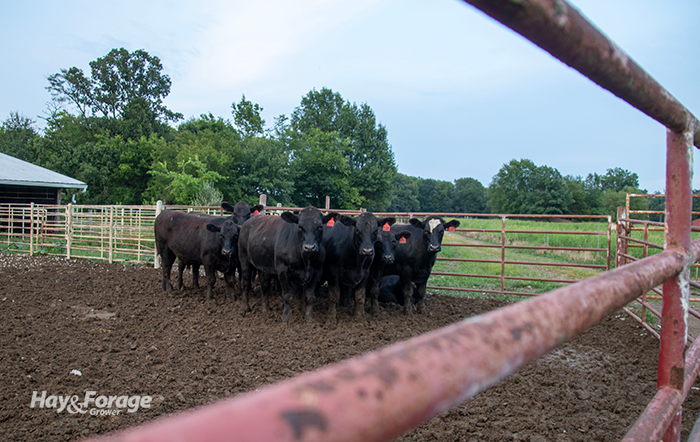
Being half forage and half grain, corn silage has the unique ability to meet a range of energy and fiber requirements. That being said, it can be a difficult ingredient to incorporate into different types of livestock diets, especially in beef systems.
The match made in forage heaven between corn silage and alfalfa makes the former crop a key component in dairy nutrition, and one that seems to have a rising inclusion rate on larger operations. Greater corn yields per acre offer incentive for producers to dedicate more of their land to the annual crop, and a single corn harvest compared to several alfalfa cuttings arguably makes growing more corn for silage a good opportunity for dairy farmers.
While corn silage has made its case in the dairy sector, it also plays an important role in almost every segment of the beef industry. From backgrounders to finishers to cows and calves, different classes of livestock can benefit from strategic utilization of corn silage grain and forage to meet energy and fiber requirements.
At the Silage for Beef Conference last month in Omaha, Neb., Jim MacDonald discussed how each beef production system can best use corn silage to its advantage, as well as some challenges it poses. The professor of ruminant nutrition at the University of Nebraska-Lincoln suggested corn silage is most effective in backgrounder diets, followed by cow diets, and lastly, in finisher diets.
Backgrounder diets. “If I were to prioritize the use of silage, it would be in backgrounder systems,” MacDonald asserted. “But the thing that you have to remember about growing calves is that they have a protein requirement that cannot be met by bacterial protein.”
Bacterial protein, or rumen-degradable protein, grows during fermentation and is broken down during digestion before being absorbed by the small intestine. Although mature cows can readily utilize these amino acids, the nutrients are virtually unavailable to growing calves. MacDonald compared the predicament to feeding his 15-year-old son whose hunger never seems to be satisfied unless he eats a significant amount of protein.
“That kid will eat three or four pork chops in one sitting without a problem because he has such a huge demand for amino acids right now because of his growth,” MacDonald chuckled. “Newly weaned calves in a backgrounding system have that same demand, and it cannot be met by bacterial protein because they cannot eat enough.”
The solution is to supplement corn silage with rumen-undegradable protein. MacDonald referred to research that showed feeding backgrounder calves 85% corn silage and 15% protein supplement on an as-fed basis yielded optimal dry matter intake and average daily gains. Dried distillers grains tend to be a practical protein option for Nebraskan beef producers.
Under an 85% corn silage and 15% dried distillers grains diet, research has shown that backgrounders can easily gain 2 to 3 pounds per day. But how much gain is too much? MacDonald said it depends on whether calves will be shipped or raised on-farm.
“If those calves are getting fat, they may receive a discount if they are being sold. If they are retained and you are feeding them out, it’s okay to fatten them — slowly.” He contended that slowly fattening backgrounder calves instead of relying on compensatory gain to kick in when they enter the feedlot is a more sustainable approach to weight gain.
Cow-calf diets. Integrating corn silage into cow-calf systems may be the most complicated strategy because of how a cow’s nutrition requirements change throughout its annual production cycle. For example, energy requirements peak in between calving and breeding when milk production is highest. Then, energy requirements taper off as calves are weaned before rising again as another calving season begins.
Body weight, overall body size, stage of lactation, and gestation all affect a cow’s energy requirements, as well as dry matter intake capacity. Although forage quality can affect dry matter intake capacity in high-forage diets, that’s not the case with corn silage.
“Here’s the thing with using corn silage in cow diets: It’s too good,” MacDonald stated. “The energy density of corn silage is too good for a cow based on how much she wants to eat.”
In other words, diets that contain too much corn silage can have adverse effects on cows, like unwanted weight gain. Therefore, corn silage in cow diets must be diluted with a low-quality forage, or cows must be limit-fed. The latter approach may require cows be kept in confinement and not allowed to graze pastures, but MacDonald said that is the best way to control body condition scores.
One drawback to limit-feeding cows in confinement is that the feeding area can be more dangerous for calves, especially at the feedbunk where the young animals are at risk of getting crushed. MacDonald also pointed out that water availability is more critical in a limit-feeding situation compared to a grazing system.
Finisher diets. Even though feeding corn silage as a roughage source to finishing cattle is a relatively common practice, MacDonald pegged this production system last on his priority list.
A study that compared corn silage inclusion rates ranging from 15% to 45% of finishing diets plus 25% modified dried distillers grains showed cattle that received greater corn silage had lower feed efficiency than those that ate less. It also took longer for these animals to finish out at an optimal hot carcass weight. However, the incidence of acidosis, and thus liver abscesses, was reduced when finishing cattle ate more corn silage. Moreover, profitability was relatively similar across all treatments.
“The 45% cattle were fed longer, because that was a necessity, but they were heavier at the end as well,” MacDonald summarized. “They ate more, they gained just a little less, so they were less efficient.”
Regardless of the production system, there is no perfect solution to feeding corn silage to beef cattle. It can be an important ingredient for all classes of livestock as long as rations are balanced accordingly to meet animal-specific needs.

